TOYOTA RAV4 EV 2013 1.G Owner's Manual
Manufacturer: TOYOTA, Model Year: 2013, Model line: RAV4 EV, Model: TOYOTA RAV4 EV 2013 1.GPages: 520, PDF Size: 7.4 MB
Page 21 of 520

21
●Disclosure of the EDR data
Toyota will not disclose the data recorded in an EDR to a third party except
when:
• An agreement from the vehicle’s owner (or the lessee for a leased vehicle) is obtained
• In response to an official request by the police, a court of law or a govern-
ment agency
• For use by Toyota in a law suit
However, if necessary, Toyota may:
• Use the data for research on vehicle safety performance
• Disclose the data to a third party for research purposes without disclosing information about the specific vehicle or vehicle owner
Scrapping of your Toyota
The SRS airbag and seat belt pretensioner devices in your Toyota contain
explosive chemicals. If the vehicle is scrapped with the airbags and seat belt
pretensioners left as they are, this may cause an accident such as fire. Be
sure to have the systems of the SRS airbag and seat belt pretensioner
removed and disposed of by a qualified service shop or by your Toyota
dealer before you scrap your vehicle. Additionally, the lithium-ion battery
(traction battery) may cause an accident such as a fire if it is not removed
prior to scrapping. The lithium-ion batte ry can be disposed of at your Toyota
dealer.
Perchlorate Material
Special handling may apply, See www.dtsc.ca.gov/hazardouswaste/perchlorate.
Your vehicle has components that may contain perchlorate. These compo-
nents may include airbag, seat belt pretensioners, and wireless remote con-
trol batteries.
Page 22 of 520

22
CAUTION
■General precautions while driving
Driving under the influence: Never drive your vehicle when under the influ-
ence of alcohol or drugs that have impaired your ability to operate your vehi-
cle. Alcohol and certain drugs delay reaction time, impair judgment and
reduce coordination, which could lead to an accident that could result in
death or serious injury.
Defensive driving: Always drive defensively. Anticipate mistakes that other
drivers or pedestrians might make and be ready to avoid accidents.
Driver distraction: Always give your full attention to driving. Anything that dis-
tracts the driver, such as adjusting controls, talking on a cellular phone or
reading can result in a collision with resulting death or serious injury to you,
your occupants or others.
■ General precaution regarding children’s safety
Never leave children unattended in the vehicle, and never allow children to
have or use the key.
Children may be able to start the vehicle or shift the vehicle into neutral.
There is also a danger that children may injure themselves by playing with
the windows, the moon roof, or other features of the vehicle. In addition, heat
build-up or extremely cold temperatures inside the vehicle can be fatal to
children.
■ Traction battery
Never resell, hand over or modify the traction battery. To prevent accidents,
traction batteries that have been removed from a disposed vehicle are col-
lected through Toyota dealers. Do not dispose of the battery yourself.
Unless the battery is properly collected, the following may occur, resulting in
death or serious injury:
●The traction battery may be illegally disposed of or dumped, and someone
may touch a high voltage part, resulting in an electric shock.
● The traction battery is intended to be used exclusively with your EV. If the
traction battery is used outside of your vehicle or modified in any way, acci-
dents such as electric shock, heat generation, smoke generation, an
explosion and electrolyte leakage may occur.
If the traction battery is resold or handed over to a third party, the possibility
of an accident is extremely high bec ause the person receiving the traction
battery may not be aware of these dangers.
Page 23 of 520

23
CAUTION
■Disposal of the traction battery
If your vehicle is disposed of without the traction battery having been
removed, there is a danger of serious electric shock if high voltage parts,
cables and their connectors are touched. In the event that your vehicle must
be disposed of, the traction battery must be disposed of by your Toyota
dealer or a qualified service shop. If the traction battery is not disposed of
properly, it may cause electric shock that can result in death or serious injury.
Page 24 of 520
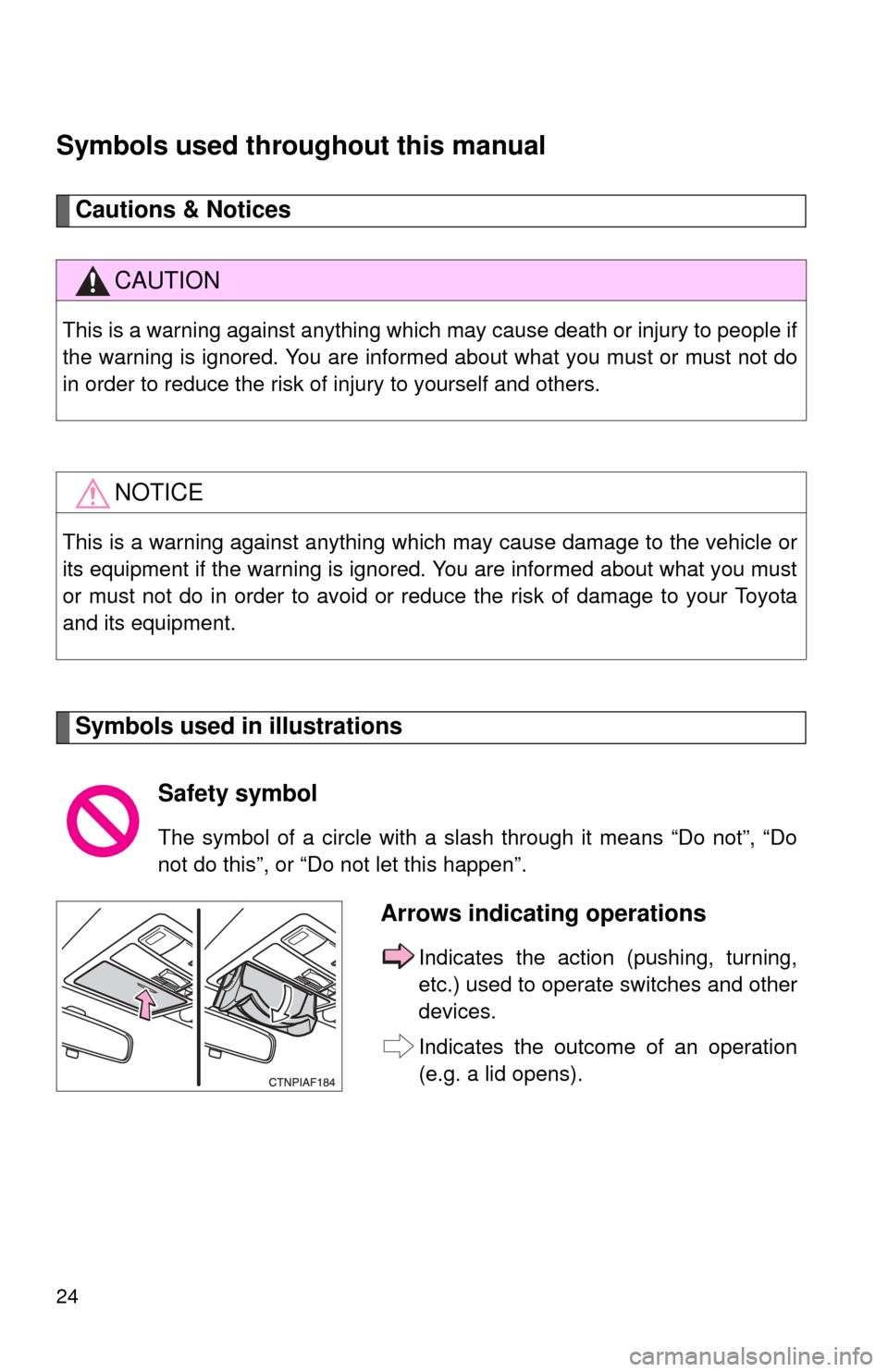
24
Symbols used throughout this manual
Cautions & Notices
Symbols used in illustrations
CAUTION
This is a warning against anything which may cause death or injury to people if
the warning is ignored. You are informed about what you must or must not do
in order to reduce the risk of injury to yourself and others.
NOTICE
This is a warning against anything which may cause damage to the vehicle or
its equipment if the warning is ignored. You are informed about what you must
or must not do in order to avoid or reduce the risk of damage to your Toyota
and its equipment.
Safety symbol
The symbol of a circle with a slash through it means “Do not”, “Do
not do this”, or “Do not let this happen”.
Arrows indicating operations
Indicates the action (pushing, turning,
etc.) used to operate switches and other
devices.
Indicates the outcome of an operation
(e.g. a lid opens).
Page 25 of 520
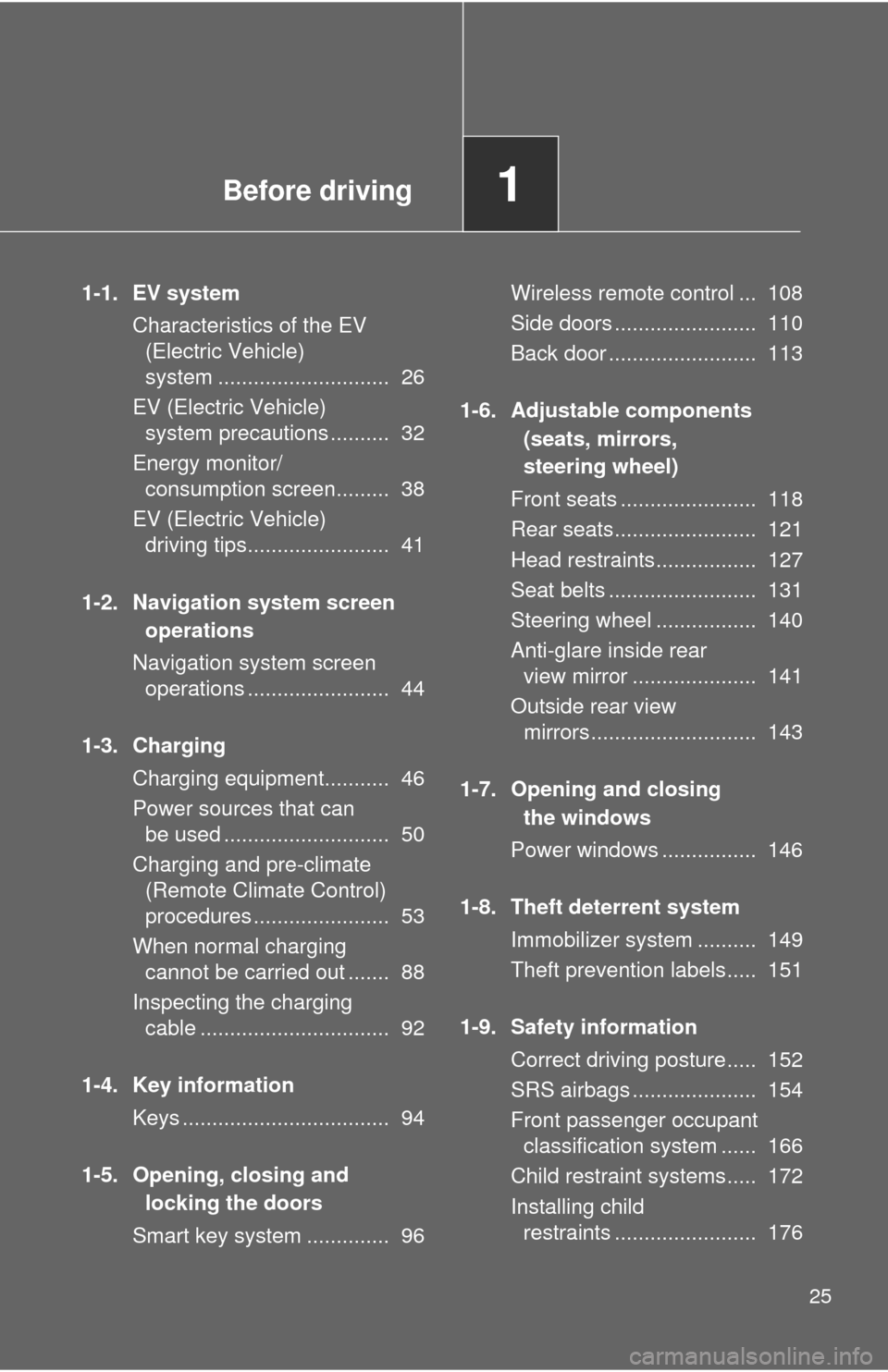
Before driving1
25
1-1. EV systemCharacteristics of the EV (Electric Vehicle)
system ............................. 26
EV (Electric Vehicle) system precautions .......... 32
Energy monitor/ consumption screen......... 38
EV (Electric Vehicle) driving tips........................ 41
1-2. Navigation system screen operations
Navigation system screen operations ........................ 44
1-3. Charging Charging equipment........... 46
Power sources that can be used ............................ 50
Charging and pre-climate (Remote Climate Control)
procedures ....................... 53
When normal charging cannot be carried out ....... 88
Inspecting the charging cable ................................ 92
1-4. Key information Keys ................................... 94
1-5. Opening, closing and locking the doors
Smart key system .............. 96 Wireless remote control ... 108
Side doors ........................ 110
Back door ......................... 113
1-6. Adjustable components (seats, mirrors,
steering wheel)
Front seats ....................... 118
Rear seats........................ 121
Head restraints................. 127
Seat belts ......................... 131
Steering wheel ................. 140
Anti-glare inside rear view mirror ..................... 141
Outside rear view mirrors ............................ 143
1-7. Opening and closing the windows
Power windows ................ 146
1-8. Theft deterrent system Immobilizer system .......... 149
Theft prevention labels..... 151
1-9. Safety information Correct driving posture..... 152
SRS airbags ..................... 154
Front passenger occupant classification system ...... 166
Child restraint systems..... 172
Installing child restraints ........................ 176
Page 26 of 520
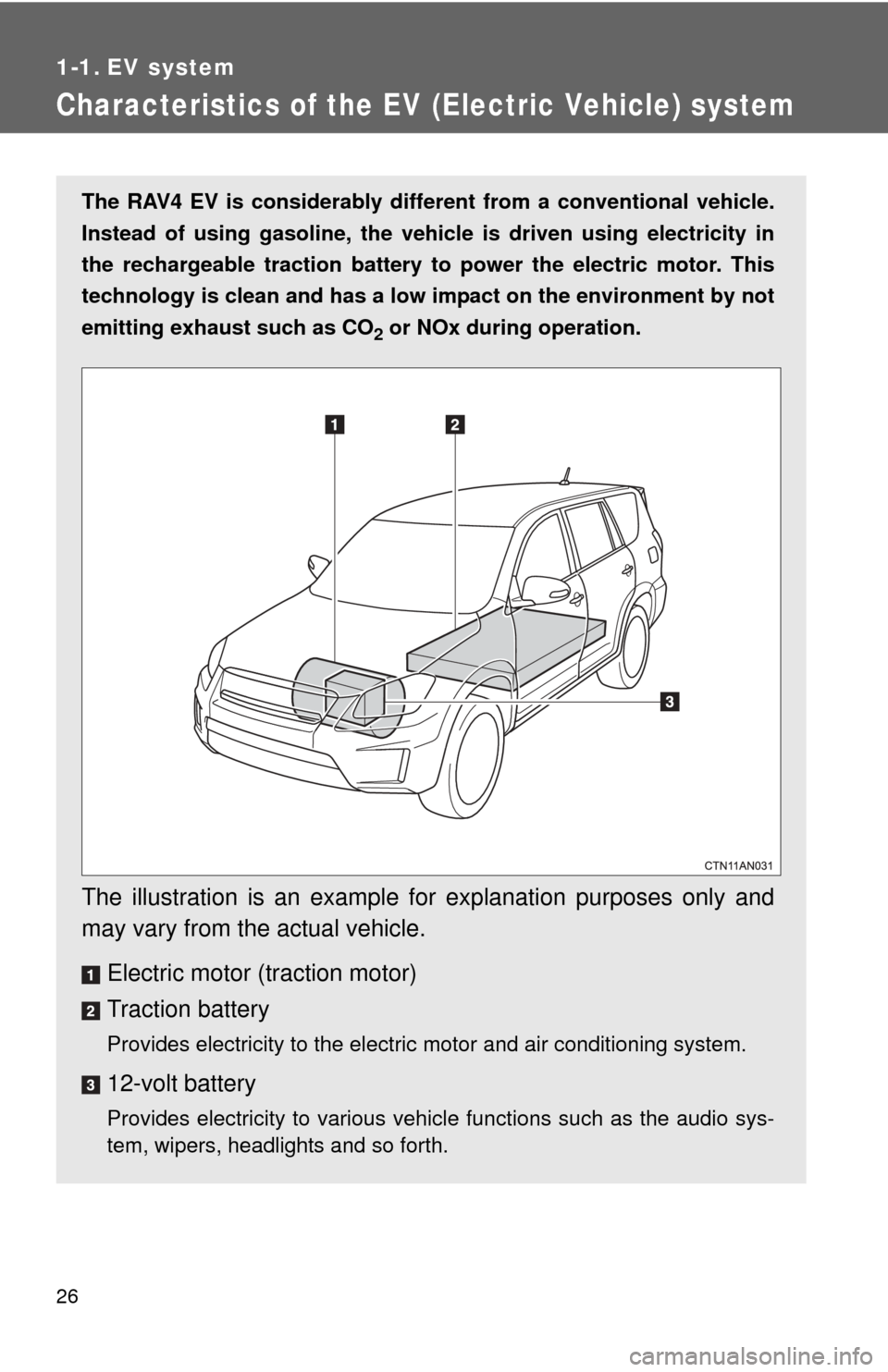
26
1-1. EV system
Characteristics of the EV (Electric Vehicle) system
The RAV4 EV is considerably different from a conventional vehicle.
Instead of using gasoline, the vehicle is driven using electricity in
the rechargeable traction battery to power the electric motor. This
technology is clean and has a low impact on the environment by not
emitting exhaust such as CO
2 or NOx during operation.
The illustration is an example fo r explanation purposes only and
may vary from the actual vehicle.
Electric motor (traction motor)
Traction battery
Provides electricity to the electric motor and air conditioning system.
12-volt battery
Provides electricity to various vehicle functions such as the audio sys-
tem, wipers, headlights and so forth.
Page 27 of 520
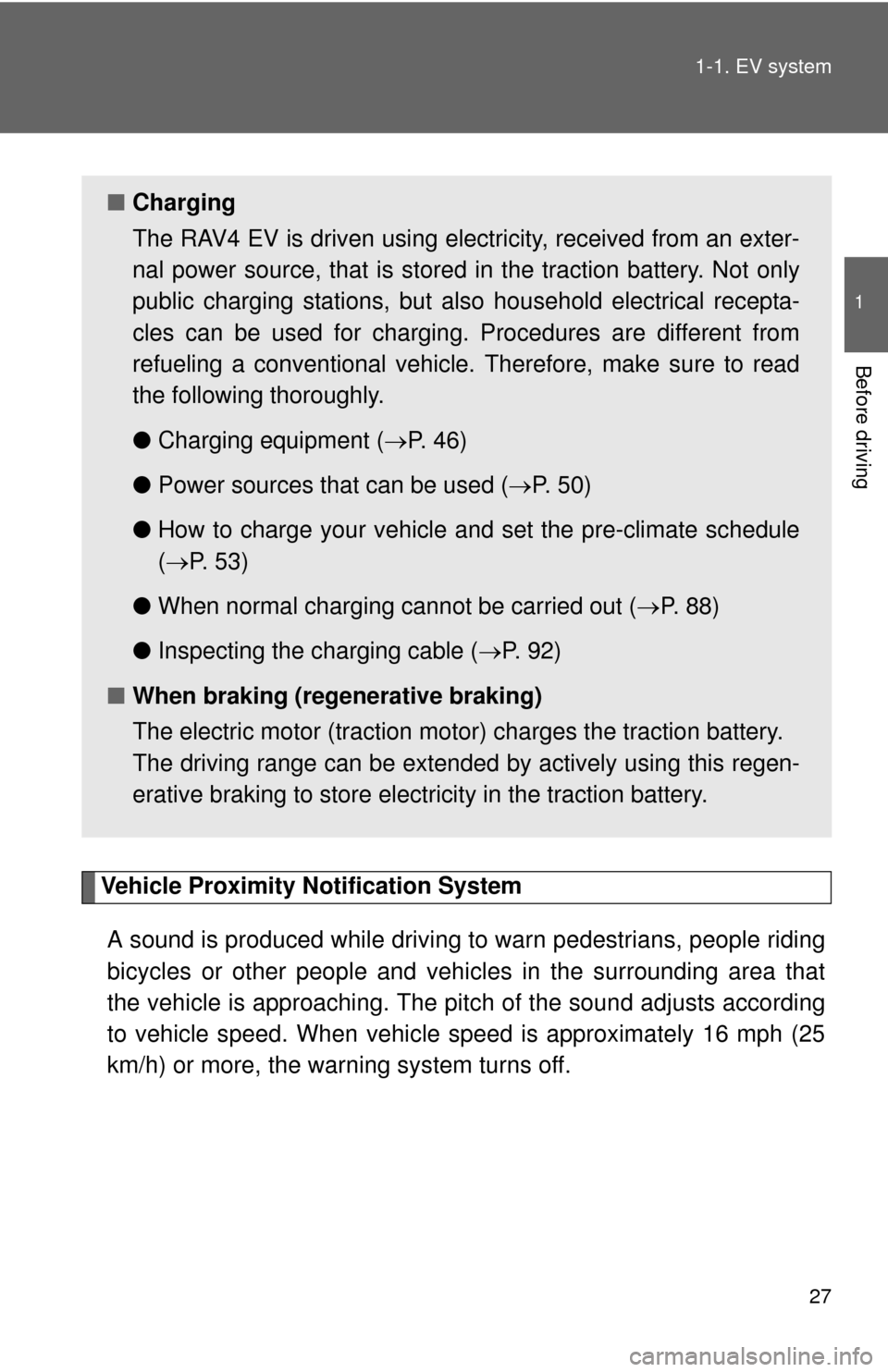
27
1-1. EV system
1
Before driving
Vehicle Proximity Notification System
A sound is produced while driving to warn pedestrians, people riding
bicycles or other people and vehi cles in the surrounding area that
the vehicle is approaching. The pitc h of the sound adjusts according
to vehicle speed. When vehicle speed is approximately 16 mph (25
km/h) or more, the warning system turns off.
■ Charging
The RAV4 EV is driven using electricity, received from an exter-
nal power source, that is stored in the traction battery. Not only
public charging stations, but also household electrical recepta-
cles can be used for charging. Procedures are different from
refueling a conventional vehicle. Therefore, make sure to read
the following thoroughly.
● Charging equipment ( P. 4 6 )
● Power sources that can be used ( P. 5 0 )
● How to charge your vehicle and set the pre-climate schedule
( P. 5 3 )
● When normal charging cannot be carried out ( P. 8 8 )
● Inspecting the charging cable ( P. 92)
■ When braking (regenerative braking)
The electric motor (traction moto r) charges the traction battery.
The driving range can be extended by actively using this regen-
erative braking to store electr icity in the traction battery.
Page 28 of 520
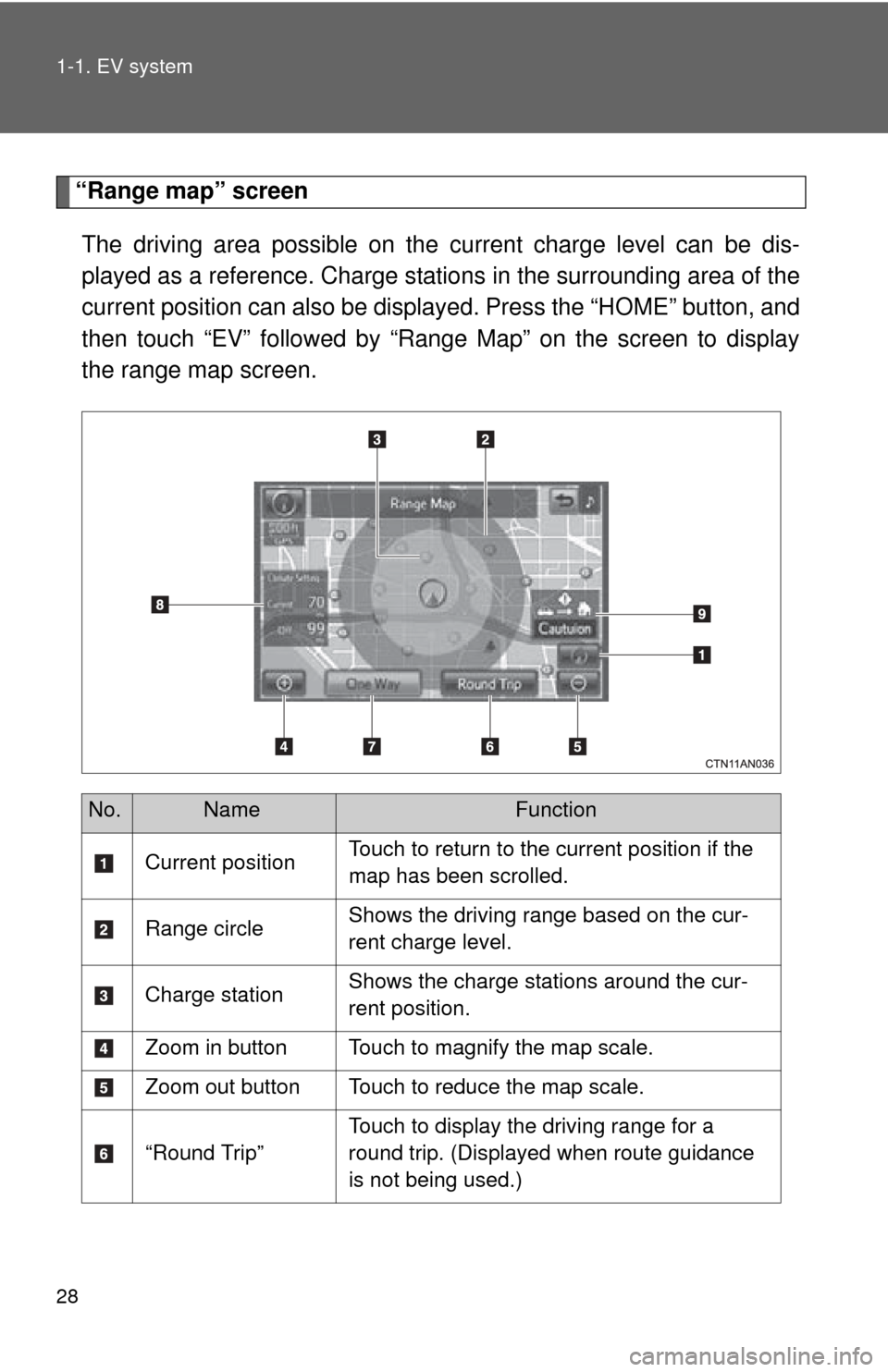
28 1-1. EV system
“Range map” screenThe driving area possible on the current charge level can be dis-
played as a reference. Charge statio ns in the surrounding area of the
current position can also be displayed. Press the “HOME” button, and
then touch “EV” followed by “Range Map” on the screen to display
the range map screen.
No.NameFunction
Current position Touch to return to the current position if the
map has been scrolled.
Range circle Shows the driving range based on the cur-
rent charge level.
Charge station Shows the charge stations around the cur-
rent position.
Zoom in button Touch to magnify the map scale.
Zoom out button Touch to reduce the map scale.
“Round Trip” Touch to display the driving range for a
round trip. (Displayed when route guidance
is not being used.)
Page 29 of 520
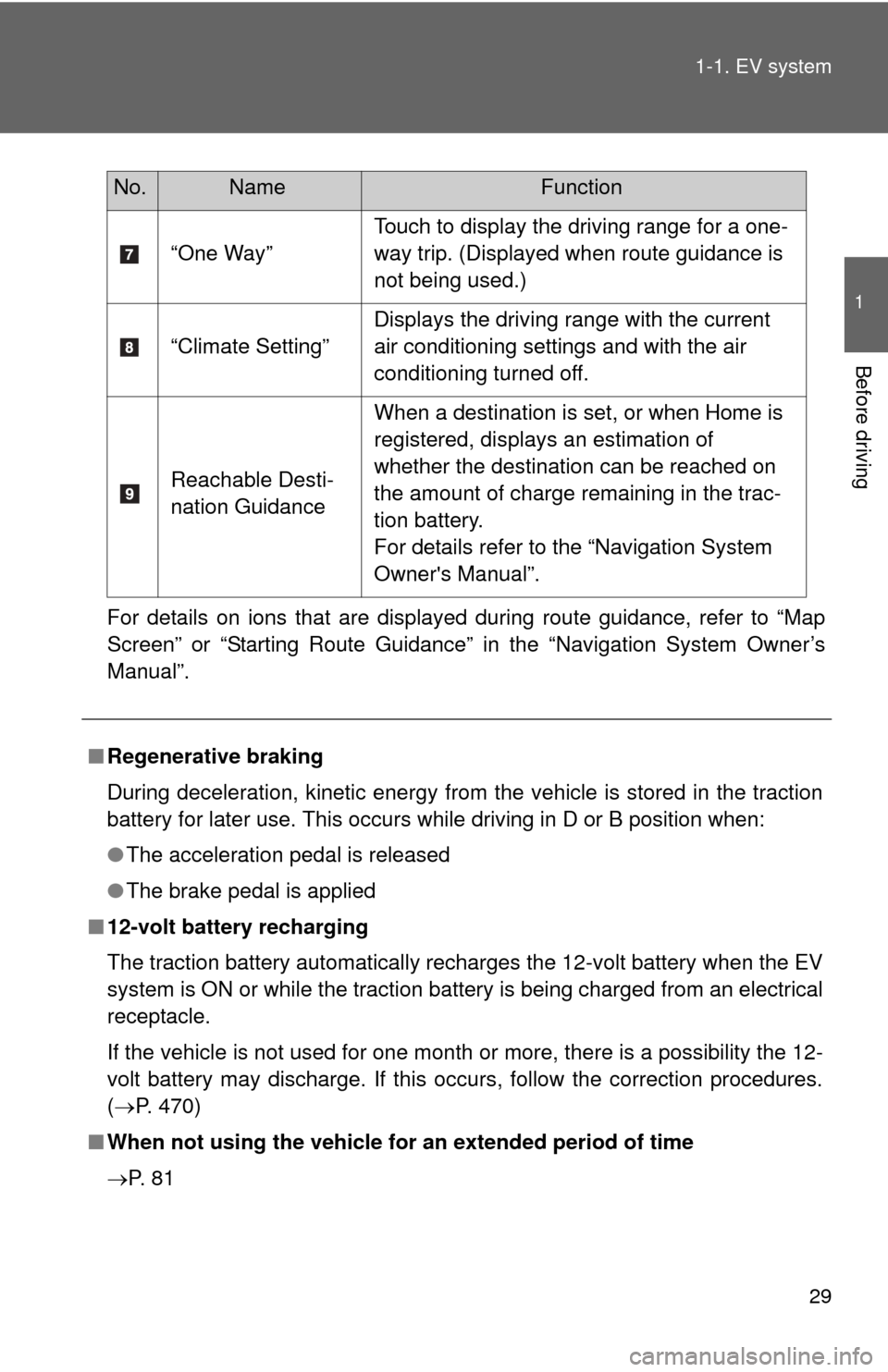
29
1-1. EV system
1
Before driving
For details on ions that are displayed during route guidance, refer to “Map
Screen” or “Starting Route Guidance” in the “Navigation System Owner’s
Manual”.
“One Way”
Touch to display the driving range for a one-
way trip. (Displayed when route guidance is
not being used.)
“Climate Setting” Displays the driving range with the current
air conditioning settings and with the air
conditioning turned off.
Reachable Desti-
nation Guidance When a destination is set, or when Home is
registered, displays an estimation of
whether the destination can be reached on
the amount of charge remaining in the trac-
tion battery.
For details refer to the “Navigation System
Owner's Manual”.
No.NameFunction
■
Regenerative braking
During deceleration, kinetic energy from the vehicle is stored in the traction
battery for later use. This occurs while driving in D or B position when:
● The acceleration pedal is released
● The brake pedal is applied
■ 12-volt battery recharging
The traction battery automatically recharges the 12-volt battery when the EV
system is ON or while the traction battery is being charged from an electrical
receptacle.
If the vehicle is not used for one month or more, there is a possibility the 12-
volt battery may discharge. If this occurs, follow the correction procedures.
(P. 470)
■ When not using the vehicle for an extended period of time
P. 8 1
Page 30 of 520
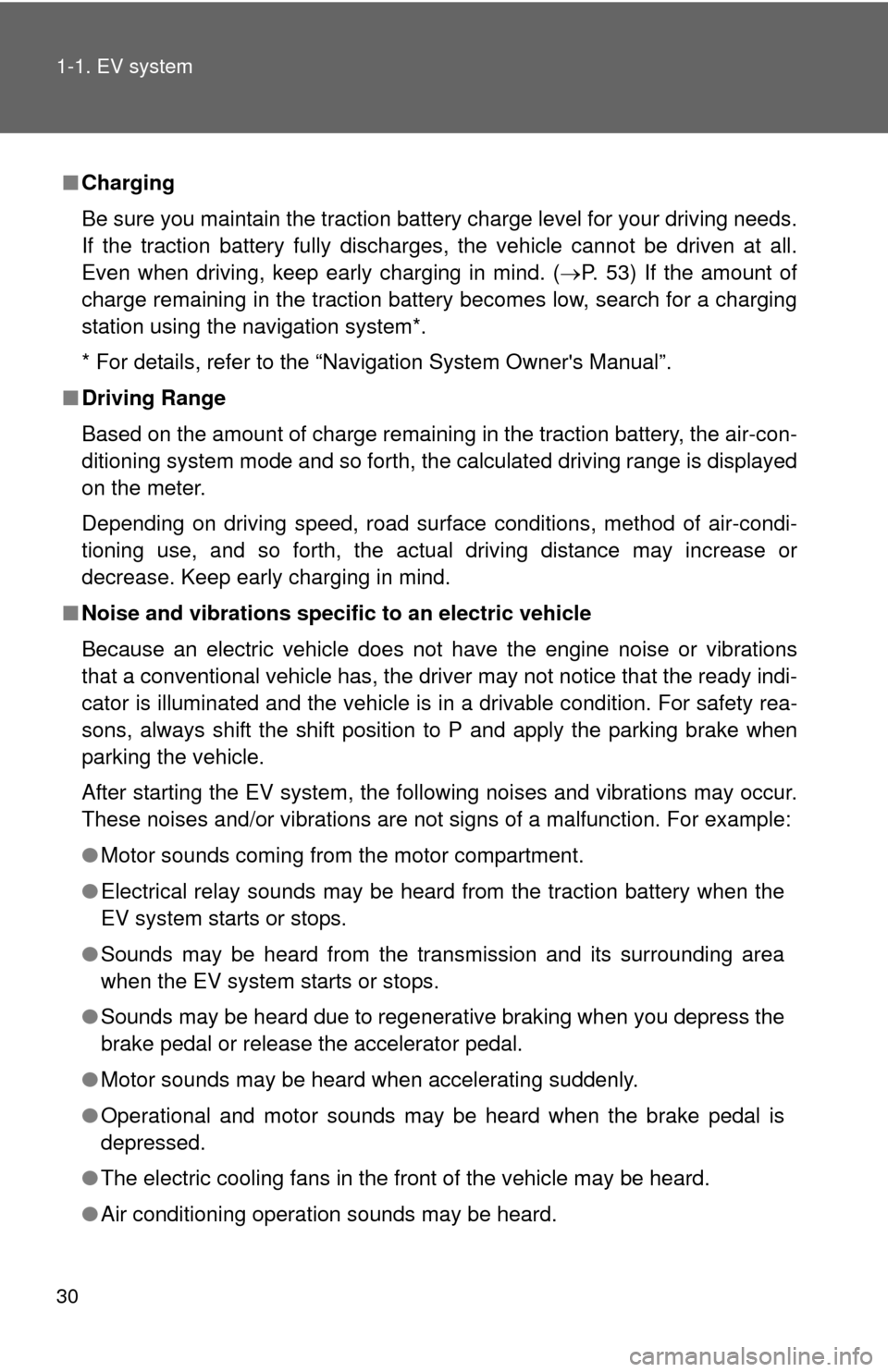
30 1-1. EV system
■Charging
Be sure you maintain the traction battery charge level for your driving needs.
If the traction battery fully discharges, the vehicle cannot be driven a\
t all.
Even when driving, keep early charging in mind. ( P. 53) If the amount of
charge remaining in the traction battery becomes low, search for a charging
station using the navigation system*.
* For details, refer to the “Navigation System Owner's Manual”.
■ Driving Range
Based on the amount of charge remaining in the traction battery, the air-con-
ditioning system mode and so forth, the calculated driving range is displayed
on the meter.
Depending on driving speed, road surface conditions, method of air-condi-
tioning use, and so forth, the actual driving distance may increase or
decrease. Keep early charging in mind.
■ Noise and vibrations specific to an electric vehicle
Because an electric vehicle does not have the engine noise or vibrations
that a conventional vehicle has, the driver may not notice that the ready indi-
cator is illuminated and the vehicle is in a drivable condition. For safety rea-
sons, always shift the shift position to P and apply the parking brake when
parking the vehicle.
After starting the EV system, the following noises and vibrations may occur.
These noises and/or vibrations are not signs of a malfunction. For example:
● Motor sounds coming from the motor compartment.
● Electrical relay sounds may be heard from the traction battery when the
EV system starts or stops.
● Sounds may be heard from the transmission and its surrounding area
when the EV system starts or stops.
● Sounds may be heard due to regenerative braking when you depress the
brake pedal or release the accelerator pedal.
● Motor sounds may be heard when accelerating suddenly.
● Operational and motor sounds may be heard when the brake pedal is
depressed.
● The electric cooling fans in the front of the vehicle may be heard.
● Air conditioning operation sounds may be heard.